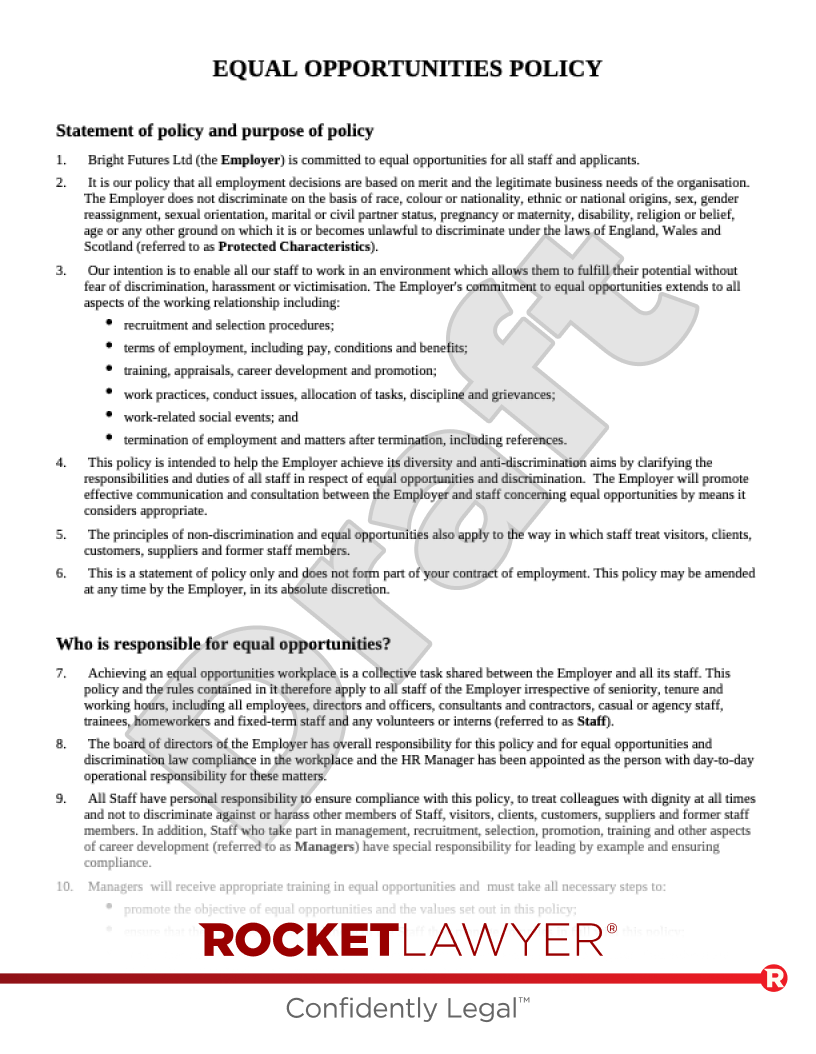MAKE YOUR FREE Equal Opportunities Policy

What we'll cover
What is an Equal Opportunities Policy?
When should I use an Equal Opportunities Policy?
Use this Equal Opportunities Policy template:
-
to help your organisation prevent unlawful discrimination and fulfil its legal duties under equality law, for example:
-
the duty to make reasonable adjustments
-
the duty not to discriminate, harass, or victimise
-
-
to ensure employees and managers are informed about equal opportunities
-
to explain what will happen if employees don't comply with rules about equal opportunities
-
only for employees based in England, Wales, or Scotland
Sample Equal Opportunities Policy
The terms in your document will update based on the information you provide
EQUAL OPPORTUNITIES POLICY
Statement of Policy and Purpose of Policy
- (the Employer) is committed to equal opportunities for all staff and applicants.
- It is our policy that all employment decisions are based on merit and the legitimate business needs of the organisation. The Employer does not discriminate on the basis of race, colour or nationality, ethnic or national origins, sex, gender reassignment, sexual orientation, marital or civil partner status, pregnancy or maternity, disability, religion or belief, age or any other ground on which it is or becomes unlawful to discriminate under the laws of England, Wales and Scotland (referred to as Protected Characteristics).
- Our intention is to enable all our staff to work in an environment which allows them to fulfill their potential without fear of discrimination, harassment or victimisation. The Employer's commitment to equal opportunities extends to all aspects of the working relationship including:
- recruitment and selection procedures;
- terms of employment, including pay, conditions and benefits;
- training, appraisals, career development and promotion;
- work practices, conduct issues, allocation of tasks, discipline and grievances;
- work-related social events; and
- termination of employment and matters after termination, including references.
- This Policy is intended to help the Employer achieve its diversity and anti-discrimination aims by clarifying the responsibilities and duties of all staff in respect of equal opportunities and discrimination.
- The principles of non-discrimination and equal opportunities also apply to the way in which staff treat visitors, clients, customers, suppliers and former staff members.
- This is a statement of policy only and does not form part of your contract of employment. This Policy may be amended at any time by the Employer, in its absolute discretion.
Who is Responsible for Equal Opportunities?
- Achieving an equal opportunities workplace is a collective task shared between the Employer and all its staff. This Policy and the rules contained in it therefore apply to all staff of the Employer irrespective of seniority, tenure and working hours, including all employees, directors and officers, consultants and contractors, casual or agency staff, trainees, homeworkers and fixed-term staff and any volunteers or interns (referred to as Staff).
- All Staff have personal responsibility to ensure compliance with this Policy, to treat colleagues with dignity at all times and not to discriminate against or harass other members of Staff, visitors, clients, customers, suppliers and former staff members. In addition, Staff who take part in management, recruitment, selection, promotion, training and other aspects of career development (referred to as Managers) have special responsibility for leading by example and ensuring compliance.
- Managers must take all necessary steps to:
- promote the objective of equal opportunities and the values set out in this Policy;
- ensure that their own behaviour and those of the Staff they manage complies in full with this Policy;
- ensure that any complaints of discrimination, victimisation or harassment (including against themselves) are dealt with appropriately and are not suppressed or disregarded.
What is Discrimination?
- Discrimination occurs in different ways, some more obvious than others. Discrimination on the grounds of any of the Protected Characteristics is prohibited by law, even if unintentional, unless a particular exception applies.
Direct Discrimination
- Direct Discrimination is less favourable treatment because of one of the Protected Characteristics. Examples would include refusing a woman a job as a chauffeur because you believe that women are not good drivers or restricting recruitment to persons under 40 because you want to have a young and dynamic workforce.
- Direct discrimination can arise in some cases even though the person complaining does not actually possess the Protected Characteristic but is perceived to have it or associates with other people who do. For example, when a person is less favourably treated because they are (wrongly) believed to be homosexual or because they have a spouse who is Muslim.
Indirect Discrimination
- Indirect discrimination arises when an employer applies an apparently neutral provision, criterion or practice which in fact puts individuals with a particular Protected Characteristic at a disadvantage, statistically and this is unjustified. To show discrimination the individual complaining also has to be personally disadvantaged. An example would be a requirement for job candidates to have ten years' experience in a particular role, since this will be harder for young people to satisfy. This kind of discrimination is unlawful unless it is a proportionate means of achieving a legitimate aim.
Victimisation
- Victimisation means treating a person less favourably because they have made a complaint of discrimination or have provided information in connection with a complaint or because they might do one of these things.
Harassment
- Harassment is defined as unwanted conduct related to a relevant Protected Characteristic (within the Equality Act 2010) which has the effect of violating an individual’s dignity or creating an intimidating, hostile, degrading, humiliating or offensive environment for that individual.
- Unlawful harassment may involve conduct of a sexual nature or it may be related to age, race, colour or nationality, ethnic or national origins, sex, gender reassignment, sexual orientation, disability, religion or belief, pregnancy or maternity.
- Harassment can arise in some cases even though the person complaining does not actually possess a Protected Characteristic but is perceived to have it (for example, when a person is harassed because they are (wrongly) believed to be homosexual) or associates with other people who possess a Protected Characteristic (for example, because they have a spouse who is Muslim).
- A person may also be subject to harassment even if they were not the intended target. For example, a person may be harassed by a sexist joke about a different gender if it created an offensive environment for them to work in.
- Harassment may include:
- use of insults or slurs based on a Protected Characteristic or of a sexual nature or other verbal abuse or derogatory, offensive or stereotyping jokes or remarks;
- physical or verbal abuse, threatening or intimidating behaviour because of a Protected Characteristic or behaviour of a sexual nature;
- unwelcome physical contact including touching, hugging, kissing, pinching or patting, brushing past, invading personal space, pushing grabbing or other assaults;
- mocking, mimicking or belittling a person's disability, appearance, accent or other personal characteristics;
- unwelcome requests for sexual acts or favours; verbal sexual advances, vulgar, sexual, suggestive or explicit comments or behaviour;
- repeated requests, either explicitly or implicitly, for dates;
- repeated requests for social contact or after it has been made clear that requests are unwelcome;
- comments about body parts or sexual preference;
- displaying or distributing offensive or explicit pictures, items or materials relating to a Protected Characteristic or of a sexual nature;
- shunning or ostracising someone, for example, by deliberately excluding them from conversations or activities;
- 'outing' or threatening to 'out' someone's sexual orientation (ie to make it known);
- explicit or implicit suggestions that employment status or progression is related to toleration of, or acquiescence to sexual advances, or other behaviour amounting to harassment;
- racists, sexist, homophobic or ageist jokes, and stereotypical remarks about a particular ethnic or religious group or gender;
- posters, graffiti, obscene gestures, flags and emblems; and
- isolation from normal work or study places, conversations or social events.
- Other important points to note about harassment:
- a single incident can amount to harassment;
- behaviour that has continued for a long period without complaint can amount to harassment;
- it is not necessary for an individual to intend to harass someone for their behaviour to amount to harassment;
- it is not necessarily for an individual to communicate that behaviour is unwelcome before it amounts to harassment; and
- the onus is on each individual to be certain that their behaviour and conduct is appropriate and is not unwanted and in the case of doubt, you must refrain from such conduct.
Disability Discrimination
- This could be direct or indirect discrimination, and is any unjustified less favourable treatment because of the effects of a disability, and failure to make reasonable adjustments to alleviate disadvantages caused by a disability.
Disabled Persons
- Any Staff member who considers that they may have a disability is strongly encouraged to speak with the , particularly if they experience difficulties at work because of their disability so that any reasonable adjustments to help overcome or minimise difficulties can be discussed. For these purposes, disability includes any physical or mental impairment which substantially affects your ability to perform day to day activities and has lasted (or is likely to last) more than 12 months. Disclosure of this information will be treated in confidence, if you wish it to be, so far as is reasonably practicable and we will do our best to handle matters sensitively and to ensure that you are treated with dignity and with respect for your privacy.
- We will consult with you about whether adjustments are needed to avoid you being disadvantaged and may ask you to see a doctor appointed by us, to advise on this. We will seek to accommodate your needs within reason. If we consider a particular adjustment unreasonable we will explain why and try to find an alternative solution.
- Managers with responsibility for managing a member of Staff who they know or think to be disabled should speak to the to ensure that all relevant duties are complied with.
Making Employment Decisions Fairly
- As noted above, the Employer will recruit employees and make other employment decisions concerning promotion, training, dismissal and related issues on the basis of objective criteria.
- Managers should only stipulate criteria or conditions for employment decisions (including job selection, promotion and redundancy) which are based on a legitimate business need and which do not go further than is needed to satisfy that need. If you are in any doubt about whether particular criteria or conditions are indirectly discriminatory or justifiable, then please speak to the .
Recruitment
- Managers involved in recruitment must:
- specify only recruitment criteria that are relevant to the job, reflect genuine business needs and are proportionate. More than one person should be involved in shortlisting of applicants wherever practicable;
- ensure that vacancies are advertised to a diverse audience and try to avoid informal recruitment methods that exclude fair competition. In very rare cases, it may be legitimate and necessary to restrict recruitment to a particular role to certain groups, but it is essential that this is discussed with the so that appropriate steps can be taken to ensure legality;
- review job advertisements carefully to ensure that stereotyping is avoided and that particular groups are not unjustifiably discouraged from applying;
- not ask applicants about health or disability before a job offer is made (other than in exceptional circumstances and after having been approved by the ). If necessary a job offer can be expressed to be conditional upon satisfactorily passing a medical check.
- not ask candidates about any Protected Characteristic if the question may demonstrate an intention to discriminate. For example, candidates should not be asked about current or future pregnancy, childcare or related matters; and
- not make assumptions about immigration status based on appearance, accent or apparent nationality;
- so far as reasonably practicable, keep a written record of their reasons for relevant decisions.
- The Employer is legally required to verify that all employees have the right to work in the UK. Prior to starting employment, all employees must produce original documents to the Employer's satisfaction, irrespective of nationality. Information about the documents required is available from the .
Staff Training, Career Development and Promotion
- Training needs may be identified during the normal appraisal process. Appropriate training to facilitate progression will be accessible to all staff.
- All promotion decisions will be made on the basis of merit and according to proportionate criteria determined by legitimate business need.
Conditions of Service
- Access to benefits and facilities and terms of employment will be kept under review to ensure that they are appropriately structured and that no unlawful barriers to qualification or access exist.
Discipline and Termination of Employment
- Any redundancy selection criteria and procedures that are used, or other decisions taken to terminate employment, will be fair and not directly or indirectly discriminatory.
- Disciplinary procedures and penalties will be applied without discrimination, whether they result in disciplinary warnings, dismissal or other disciplinary action.
Discipline and Termination of Employment
- Part-time and fixed-term staff will be treated the same as full-time or permanent staff of the same position and enjoy no less favourable terms and conditions (pro-rata, where appropriate), unless different treatment is justified.
What to Do If You Encounter Discrimination
- If you believe that you have been the victim of discrimination, you should follow the Employer's Grievance Procedure.
- Every member of Staff has a responsibility to combat discrimination if they encounter it. Staff who observe or are aware of acts that they believe amount to discrimination directed at others are encouraged to report these to the .
- Any grievance or report raised about discrimination will be kept confidential so far as this is practicable. We may ask you if you wish your complaint(s) to be put to the alleged discriminator if disciplinary action appears to be appropriate. It sometimes may be necessary to disclose the complaint or take action even if this is not in line with your wishes, but we will seek to protect you from victimisation and, if you wish, we will seek to protect your identity. You should be aware that disciplinary action may be impossible without your co-operation or if you refuse to allow relevant information to be disclosed.
- Staff who raise a complaint about or report discrimination in good faith will be protected from retaliation or victimisation. As long as you act in good faith, the fact that you have raised a complaint or report will not affect your position within the Employer, even if the complaint is not upheld. Making a false allegation deliberately and in bad faith is a misconduct offence and will be dealt with in accordance with our Disciplinary Policy. Any member of Staff who attempts acts of retaliation or victimisation may be subject to disciplinary action up to and including summary dismissal for gross misconduct.
- If you make a complaint, it may be necessary to ask you to stay at home on paid leave while investigations are being conducted and the matter is being dealt with through the appropriate procedure. This may particularly be necessary in cases of alleged harassment.
Non-compliance With Equal Opportunities Rules
- Any breach of equal opportunities rules or failure to comply with this Policy will be taken very seriously and is likely to result in disciplinary action against the offender, up to and including immediate dismissal.
- Staff should also note that:
- in some cases, they may be personally liable for their acts of discrimination and that legal action may be taken against them directly by the victim of any discrimination; and
- it may be a criminal offence intentionally to harass another employee.
Review of This Policy
- The Employer encourages Staff to comment on this Policy and suggest ways in which it might be improved or ask any questions if they are unsure about any part of this Policy or how it is applied by contacting the .
Attribution
- This Equal Opportunities Policy was created using a document from Rocket Lawyer (https://www.rocketlawyer.com/gb/en).
About Equal Opportunities Policies
Learn more about making your Equal Opportunities Policy
-
How to make an Equal Opportunities Policy
Making your Equal Opportunities Policy online is simple. Just answer a few questions and Rocket Lawyer will build your document for you. When you have all the information about your equal opportunities practices prepared in advance, creating your document is a quick and easy process.
To make your Equal Opportunities Policy you will need the following information:
Parties and responsibilities
-
Who is the employer (ie the business or other organisation)?
-
Who holds overall responsibility for equal opportunities? This may be an individual, a committee, or the Board of Directors.
-
Who holds day-to-day responsibility for equal opportunities? This is an individual person who is responsible for tasks like answering employees’ questions about equal opportunities.
-
Who should employees contact with questions about requirements for legally working in the UK (ie immigration inquiries)?
Monitoring
-
Will you undertake equality monitoring? If so:
-
Which protected characteristics will you monitor?
-
Will your equality monitoring include monitoring of recruitment processes?
-
Communication
-
Will you take active steps to communicate and consult with employees about equal opportunities?
Training
-
Do you provide equal opportunities training for managers?
-
-
Common terms in an Equal Opportunities Policy
Equal Opportunities Policies are an important part of compliance with an important area of law. To create a comprehensive Equal Opportunities Policy, this template includes sections covering:
-
statement of policy and purpose - this section explains why the Equal Opportunities Policy is important and briefly overviews what equal opportunities means, which areas of employment it spans, and how it’s promoted in practice. It also explains that, as an employment policy only, this document doesn’t form part of employees’ employment contracts and the employer may amend it as required
-
who is responsible for equal opportunities? - this section explains the general responsibility of all staff to support and uphold equal opportunities and anti-discrimination practices. It also assigns overall and day-to-day responsibility for equality in the workplace and describes the special (ie enhanced) responsibilities of managers. If you indicate that you will provide training for managers, this section will also cover this
-
what is discrimination? - this section provides definitions and examples of different types of discrimination. It’s an important section for communicating equality principles and practices to staff
-
disabled persons - provides information about disability and encourages staff members who have a disability (and their managers) to speak with the person assigned day-to-day responsibility for equal opportunities if any reasonable adjustments are required
-
making employment decisions fairly - this section outlines how recruitment and other staff management practices should be carried out to promote equal opportunity. It provides guidance for staff members who are responsible for this staff management. It covers multiple matters including:
-
explaining what types of criteria are appropriate for making decisions (ie generally those which are objective and for legitimate business aims)
-
reminding managers of their responsibility to check that staff have a legal right to work in the UK, whilst emphasising that this should be checked in a manner that doesn’t make any assumptions about people’s ethnicity or immigration status (eg by requiring all staff members to provide proof of their right to work in the UK)
-
setting out what (if any) information you monitor and why, and that providing this information is voluntary
-
-
what to do if you encounter discrimination - this section tells staff members what to do if they experience discrimination or if they believe somebody else has. It covers following the employer’s Grievance procedure and contacting the person with day-to-day responsibility for equal opportunities. It covers confidentiality and protection from retaliation or victimisation during the complaint process
-
non-compliance with equal opportunities rules - explains that individuals may be liable for discrimination or harassment that they commit against others and that the employer may take disciplinary action against anybody who doesn’t comply with this Equal Opportunities Policy
-
review - explains that the Equal Opportunities Policy will be reviewed when appropriate and encourages staff to contact the person with day-to-day responsibility with any suggestions or questions about equality
If you want your Equal Opportunities Policy to include further or more detailed provisions, you can edit your document. However, if you do this, you may want a lawyer to review the document for you (or to make the changes for you) to make sure that your modified Equal Opportunities Policy complies with all relevant laws and meets your specific needs. Use Rocket Lawyer’s Ask a lawyer service for assistance.
-
-
Legal tips for employers
Only make commitments in your Equal Opportunities Policy that you can reasonably fulfil
Some of the practices set out in this Equal Opportunities Policy (eg equality monitoring, consulting with staff on equality, and providing training) are not legal requirements. It’s great to commit to doing these things. However, if it’s not realistic for your organisation to actually implement these practices, you should not commit to doing them and then fall short. It may not be realistic or appropriate for very small businesses, for example, to monitor staff’s equality data.
Think beyond your Equal Opportunities Policy
It’s great to have an Equal Opportunities Policy in place and to successfully implement it. But, if you’re serious about promoting equality and preventing discrimination in the workplace and the wider world, there’s always more to do. As an employer, this could include having other policies in place that consider equality and fair treatment, for example, a Recruitment policy and an Anti-harassment and bullying policy.
Consider other initiatives that you could introduce in your workplace. For example, you could run awareness events or set up committees for promoting the wellbeing of different groups of people who share a protected characteristic.
Avoid discrimination by understanding exactly what constitutes it
Determining what constitutes discrimination, objective justification, or positive action can be difficult. The FAQs above provide a starting point. For more information on these topics, read:
-
The EHRC’s Employment Statutory Code of Practice, which provides detailed guidance for employers
-
The Government Equalities Office's guidance on positive action
You can also Ask a lawyer for assistance.
Understand when to seek advice from a lawyer
If you’re unsure about how to understand and implement your Equal Opportunities Policy, it’s a good idea to Ask a lawyer for assistance. Consider asking for advice if you:
-
have employees based outside England, Wales, and Scotland
-
want help determining if something (eg a procedure or criterion) constitutes discrimination
-
are unsure how to resolve a complaint of discrimination
Equal Opportunities Policy FAQs
-
What is included in an Equal Opportunities Policy?
This Equal Opportunities Policy template covers:
-
the Equal Opportunities Policy’s aims and purposes
-
who holds responsibility for equal opportunities and the roles of managers and of other staff
-
explaining and providing examples of different types of discrimination and prohibited behaviours
-
arrangements and reasonable adjustments for workers who have disabilities
-
avoiding discrimination during recruitment and throughout the employment relationship
-
what staff members and managers should do if they’re discriminated against or if discrimination is observed
-
possible sanctions for breach of this Equal Opportunities Policy or equality law
-
-
What is equal opportunities and discrimination law?
Equal opportunities and discrimination law is a vast area of law, largely consolidated in the Equality Act 2010. It aims to ensure that all employees and potential employees of an organisation are treated equally and that they have equal opportunities to take on new roles and to be given new promotions, pay and benefits, training, and more. It also makes sure that employees are treated equally when being considered for redundancy or dismissal.
This is achieved by preventing discrimination against all individuals based on ‘protected characteristics’ (eg sex, race, or disability). Discrimination can take many forms, some less obvious than others.
A significant part of ensuring equal opportunities is every employer’s duty to make ‘reasonable adjustments’ (eg to recruitment or work processes) to reduce barriers that people with disabilities face to being equally involved.
For more information, read Equal opportunities and discrimination, Disability and reasonable adjustments, and the FAQs below.
-
Why do I need an Equal Opportunities Policy?
There’s no legal requirement to have an Equal Opportunities Policy in place. However, the Equality and Human Rights Commission (or the ‘EHRC’, Great Britain’s national equality body) recommends that organisations have an Equal Opportunities Policy in place to help them set out and follow a clear, comprehensive, and systematic approach to enhancing equal opportunity and preventing discrimination in the workplace.
Having an Equal Opportunities Policy in place helps you communicate your strategy to employees and managers. This ultimately helps you to uphold the important values that sit at the heart of equality law, whilst helping you avoid any Employment Tribunal disputes that could arise as a result of non-compliance.
-
What are protected characteristics?
The Equality Act 2010 specifies 9 protected characteristics. These are:
-
age
-
sex
-
race
-
pregnancy and maternity
-
marital and civil partnership status
-
sexual orientation
-
gender reassignment
-
religion or belief
Discriminating against workers and employees because of any of these characteristics is against the law.
-
-
What are the types of discrimination?
Discrimination can take various forms, all of which are usually prohibited. These include:
-
direct discrimination - when a worker is treated less favourably than others because of their status regarding one or more of the protected characteristics
-
indirect discrimination - when a worker with a protected characteristic is put at an unfair disadvantage due to an employer putting a provision, criterion, or practice in place that applies to all workers equally (ie it appears neutral) but which affects those with a given protected characteristic unequally
-
harassment - when someone's dignity is being violated by unwanted behaviour linked to a protected characteristic that creates a hostile, humiliating, degrading, or offensive environment for them. Treating someone unfavourably because they refuse to be subject to harassment is similarly prohibited
-
victimisation - when someone is treated unfairly because they have, for example, made an allegation or given evidence or information about discrimination or harassment that has occurred
-
discrimination arising from disability - when someone with a disability is discriminated against based on something that arises as a consequence of their disability, rather than based on their disability itself (eg because they had to take time off work or because they must take more rest breaks at work)
-
-
What is an objective justification?
Discrimination can, in rare circumstances, be permitted if you can show an ‘objective justification’ for its use. For example:
-
direct discrimination based on age may sometimes be justified if, for example, it’s a reasonable way of ensuring workforce safety
-
indirect discrimination may be justified if it is a ‘proportionate means of achieving a legitimate aim’ (eg if it’s essential for the aim of upholding health and safety)
For more information, read Equal opportunities and discrimination.
-
-
What is positive action?
Positive action is a measure taken to improve access to opportunities (or to reduce discrimination) for a particular group who share a protected characteristic. Positive action must be appropriate and must address a legitimate need.
For more information, read Equal opportunities and discrimination. If you’re not sure if a practice constitutes unlawful discrimination or not, you can Ask a lawyer for assistance.
-
What aspects of employment and the workplace are affected by equal opportunities law?
The law protects everybody against discrimination at work. This includes avoiding unlawful discrimination during or related to:
-
promotion and transfer opportunities
-
workplace culture and social events
-
interpersonal relationships between colleagues
-
disciplining staff and dealing with grievances
-
training
-
What is equal opportunities monitoring?
Equal opportunities monitoring (or ‘equality monitoring’) is the process of collecting, analysing and storing data about staff’s and job applicants’ protected characteristics in order to:
-
establish whether an Equal Opportunities Policy is working
-
investigate whether more could be done to promote equality (eg positive action)
-
set targets and make strategies for better promoting equality, and
-
to emphasise the employer’s commitment to diversity and equality
Monitoring is not legally required, but it is recommended to help employers meet their legal obligations.
If you undertake equal opportunities monitoring you must be careful to comply with data protection laws. For more information, read Data protection.
For more information on equality monitoring, read the EHRC’s Employment Statutory Code of Practice.
-
-
Who is responsible for equal opportunities in the workplace?
Everybody in a workplace has a responsibility to adhere to the provisions of their employer’s Equal Opportunities Policy and to equality law more broadly.
Those in senior positions (eg business owners, chief executives, and directors) are responsible for the implementation, review, and monitoring of the organisation’s Equal Opportunities Policy. They’re also responsible for making sure that others are aware of their obligations. People with responsibility for others, especially for hiring, must pay special attention to their equality law adherence when managing others’ employment.
It’s also a good idea to appoint somebody to have responsibility for monitoring and implementing your Equal Opportunities Policy on a day-to-day basis. This helps coordinate implementation and ensures staff know who to go to with any questions.
-
What is the procedure for reporting discrimination?
Somebody who believes they have been discriminated against has the right to seek a remedy via an Employment Tribunal. However, where possible, it’s often less cumbersome and less stressful for both sides to attempt to resolve a breach of equality rights between themselves first.
You can make a Grievance procedure to let staff know how they should report discrimination. You should ensure employees are aware that, if they observe or are aware of acts that they believe may amount to discrimination, they should report them to the appropriate person or department.
-
What are the consequences of not complying with an Equal Opportunities Policy?
If an employee doesn't comply with their employer’s Equal Opportunities Policy by discriminating against somebody else, they may be subject to disciplinary action. Such behaviour may lead to the dismissal of that person. This applies to all employees, including those who hold senior positions.
Moreover, discrimination opens you up to the risk of legal liability. For instance:
-
employers are usually liable for discriminatory practices committed by their employees if they didn’t take all reasonable steps to prevent the employee from acting unlawfully in this way
-
employees may be personally liable for acts of discrimination
For more information, read Equal opportunities and discrimination.
-
-
Do I have to train staff on equal opportunities?
There is no legal requirement to train staff on equal opportunities and discrimination. Employers do, however, have a responsibility to effectively implement their Equal Opportunities Policy. Part of this is ensuring staff members understand the Equal Opportunities Policy’s provisions and providing training is a good way of doing this.
It’s especially prudent to train people responsible for recruitment and for managing employees (eg people who handle grievances and disciplinary matters). These are the people most likely to inadvertently discriminate and to be the subject of discrimination allegations.

Our quality guarantee
We guarantee our service is safe and secure, and that properly signed Rocket Lawyer documents are legally enforceable under UK laws.
Need help? No problem!
Ask a question for free or get affordable legal advice from our lawyer.





